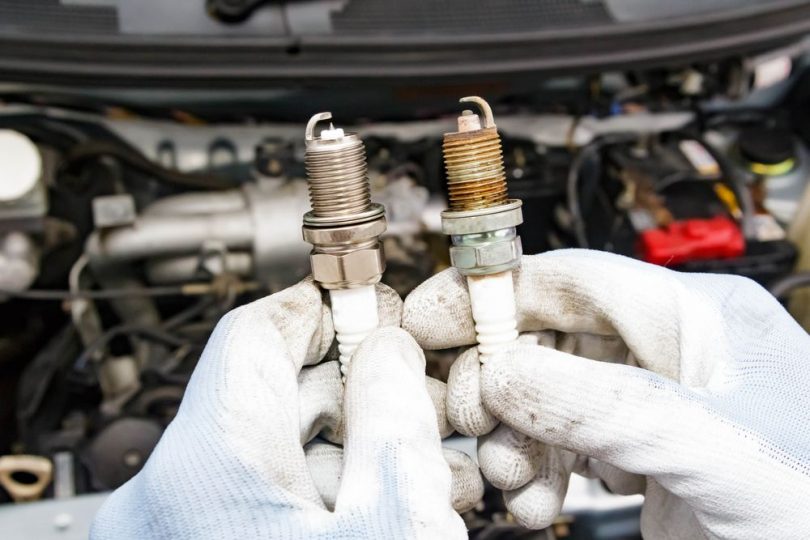When maintaining a car, spark plugs should be near the top of the list. These small plugs have a big job to do. Having them in working order will save wear and tear on your engine and save you money.
Here we’ll learn the symptoms of failing spark plugs, when to replace them, how to change them, and what can go wrong if you don’t.
How Long Should a Spark Plug Last?

How long your spark plugs last will depend on what they are made of. The higher the spark plug quality, the longer it will last. Double platinum spark plugs claim to last 100,000 miles, while your everyday copper spark plug lasts for 10,000 to 20,000 miles.
Older models using silver spark plugs get about 20,000 miles. More expensive spark plugs made of platinum or iridium last for 60,000 miles, and extended-life spark plugs can last up to 100,000 miles.
The high-end iridium plugs last the longest at over 100,000 miles, with the extended version serving you up to 120,00 miles.
How to Tell if You Need New Spark Plugs: 7 Signs to Look For
1. It’s harder to start the car
Spark plugs ignite the spark that starts the engine. Any damage, corrosion, or old spark plugs will diminish the spark and result in a rough start, a prolonged starting time, or an engine that won’t turn over.
Colder weather can make this even harder. Your repeat attempts to start the car could damage the starter, drain the battery and even damage the engine.
2. Misfiring engine
A sure sign the plugs are bad is engine misfire. A sputtering noise, a jerky feeling, and power loss to the engine will confirm this. Poor gas mileage, poor car performance, the engine idling roughly, higher emissions than usual, and catalytic convertor damage can result from not fixing the cause of the misfiring.
3. Poor gas economy
When the gap in the spark plugs isn‘t perfect, the insufficient sparks will increase the gas emissions and eat up gas. If your gas mileage isn’t what it used to be, the spark plugs could be the problem.
4. Decrease in acceleration
Shoddy spark plugs can cause slower acceleration as you step on the gas pedal.
While the cause of this can also be a bad fuel pump, clogged fuel injectors, and defective sensors, the spark plugs are easy and inexpensive to check.
So, have them looked at as soon as possible.
5. Check engine light is on
The check engine light comes on when something is wrong, don’t ignore it. Find out what is wrong before the problem gets more expensive. More times than not, the cause is carbon build-up created by bad spark plugs.
6. Car idles roughly
Another sign of faulty spark plugs is knocking, rattling, and pinging with unusual vibrations. If any of these start happening, you need to get the spark plugs checked.
7. Manufacturer recommendations
The owner’s manual is the best place to get information about your spark plugs and your car’s requirements. Here, you can find the type of plugs your car needs, the recommended gap, and when to change them.
When do spark plugs need replacing?
Most spark plugs need changing at 60,000 to 100,00 miles. The type of spark plugs you buy, how well you maintain the car, and how hard you are on the engine will all affect the life of the spark plugs.
You may have to change them sooner, and if you don’t drive your car often or get regular tune-ups, the spark plugs may last longer.
What can happen if you don’t change spark plugs?
Eventually, the spark plugs will deteriorate. Spark plugs are gapped to a measured space. Carbon build-up and damage to the spark plug and its wires can happen when you are driving.
The ignition coil will need more increased voltage to start a spark. Too much voltage creates the engine misfires. Over time, the misfires can cause a decrease in fuel economy, combustion issues, loss of engine power, and soon the car won’t start.
How to Change Your Spark Plugs?
Step 1
Parking your car on a flat surface, make sure the engine is cold. If you decide to disconnect the battery, be sure you don’t cross the battery connections or knock a tool against one, it will be a shocking experience!
Step 2
You need to remove the air cleaner and the vanity cover before starting. Once they are off, clean any dirt and debris from the area, you will be working on.
Step 3
Pull up or (depress) the ignition coil electrical connector. Use a rocking motion to remove it from the coil. Then loosen and remove the bolt that holds the coil down and remove the whole boot and coil assembly.
Step 4
Remove any grime and dirt from the plugs. Using a spark plug socket, turn the socket counterclockwise and loosen the plug. It sounds easy, but smaller cars have less space, so it could be a tight squeeze.
Step 5
Check your owner’s manual for the specs before gapping the spark plugs. Be sure to gap the spark plugs before you install them.
Use a gap gauge to get the correct gap by pulling it between the electrodes. If there is too big a gap, gently press the side electrode down. If the gap is too small, pry the gap gauge between the electrodes and open them to the proper gap. Then put a small bead of an anti-seize compound on the plug threads and use your hand to thread the spark plug into the cylinder head.
Step 6
Around the inside of the spark plug boot, coat it with dielectric grease. Then work backward and reinstall the ignition coil, the coil electrical connector, and the hold-down bolt. Now you can put the air cleaner and vanity cover back in place.
Step 7
Start the car and make sure it starts without issues.
FAQs
1. What’s the best spark plug replacement solution?
Ans. The best replacement spark plugs are the plugs recommended for your car by the
manufacturer. You can also buy the extended version of the recommended spark plugs and a variation of them like platinum, silver, or iridium vs standard copper spark plugs.
2. What will spark plugs cost?
Ans. Spark plug prices are affected by regular or extended use and the material they make them from (copper, silver, iridium.) Standard copper spark plugs start at $16 and increase with upgrades costing $100. If you do them yourself, there’s no labor cost. But a mechanic may charge up to $150 for labor.
3. How many spark plugs will I need for my diesel engine?
Ans. No diesel engines use spark plugs, so the answer is none!










Leave a Comment